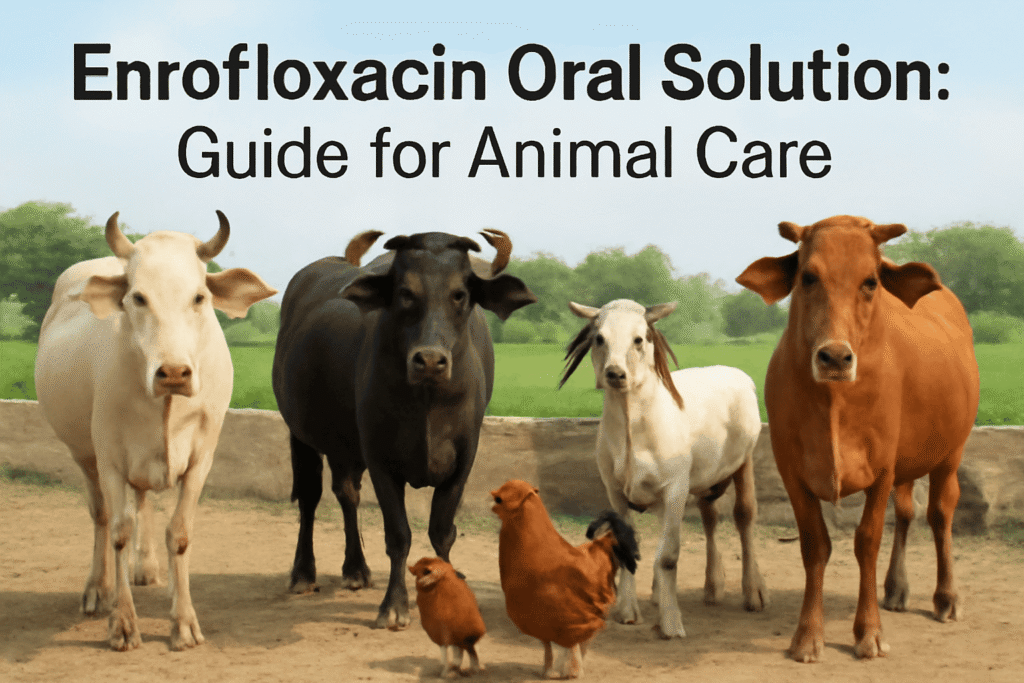
Enrofloxacin oral solution is a veterinary fluoroquinolone used under veterinary supervision to treat bacterial infections in poultry, livestock, and companion animals when culture and sensitivity results support its use. In India, it’s widely available through veterinary channels and commonly formulated alone or combined with bromhexine for respiratory indications in poultry, but its use is shaped by evolving food safety and antimicrobial stewardship regulations.
What It’s Used For in India
- Poultry: Treatment of respiratory and enteric infections caused by susceptible bacteria, including E. coli, Salmonella, Pasteurella/Mannheimia, Mycoplasma, and others, often via drinking water medication using oral solutions.
- Livestock: Used when indicated by a veterinarian for bacterial diseases in calves and pigs; injectables are more common for respiratory disease, while oral solutions are available depending on local protocols.
- Pets: Used for susceptible infections under veterinary guidance; human OTC use is not appropriate and veterinary-specific dosing is required.
How It Works
Enrofloxacin inhibits bacterial DNA gyrase and topoisomerase IV, blocking DNA replication and leading to bacterial death at adequate concentrations. It also metabolizes to ciprofloxacin, which contributes to activity.
India-specific Regulatory Context
- Food animal production is under tighter scrutiny for antibiotic use and residues, with FSSAI’s 2024 amendment effective April 1, 2025 strengthening prohibitions on certain antibiotics and revising tolerance limits for residues in food from animal sources.
- The amendment explicitly bans specific antibiotic classes and molecules in food-producing animals and updates residue tolerance lists, while noting that some highest priority critically important antibiotics like enrofloxacin require careful regulation due to prior gaps.
- Historically, India has moved toward clearer tolerance limits for veterinary drugs in food, with FSSAI standard-setting and CDSCO oversight of veterinary drug approvals.
- Practical takeaway: Only use enrofloxacin in food animals when prescribed by a veterinarian, follow label and legal requirements, and adhere strictly to withdrawal times to meet residue standards.
Dosing and Administration Basics
Always follow the product label and a veterinarian’s instructions, since dosing varies by species, disease, and formulation. In Indian poultry practice, oral solutions are typically administered via drinking water with dosing calculated by mg/kg and adjusted for real water intake and body weight. Calculate carefully during heat stress or disease when water consumption changes to avoid under- or overdosing.
Withdrawal Times and Residue Compliance
Withdrawal periods depend on species, dose, duration, and local residue limits. Research on broilers medicated via drinking water at 10 mg/kg for 5 days has shown that enrofloxacin residues may meet EU MRLs after about 5 days, while stricter Japan limits suggest around 9 days before slaughter. Producers should follow the specific product label and the prescribing veterinarian’s guidance to ensure compliance with Indian residue standards and any buyer program requirements. Field studies in the region indicate farmers often do not adhere to withdrawal guidance, underscoring the need for better compliance and vendor counseling.
Safety and Precautions
- Common issues: Occasional gastrointestinal upset; rare neurologic signs may occur.
- Young animals: Avoid in growing dogs due to cartilage concerns; use caution based on veterinary advice.
- Cats: Use judiciously and avoid overdosing due to risk of retinal toxicity at high exposures.
- Special populations: Use carefully in animals with renal or hepatic disease, seizure disorders, or during pregnancy, and avoid in quinolone hypersensitivity.
Antimicrobial Stewardship in the Indian Context
- Reserve use for confirmed or strongly suspected susceptible bacterial infections and avoid routine prophylaxis.
- India’s shift in policy, including a prior national ban on colistin in food animals and new FSSAI rules, reflects a push to curb resistance in the food chain, with concerns that unrestricted substitution to other classes like fluoroquinolones could undermine progress.
- For poultry and aquaculture supply chains, regulatory attention and residue monitoring expectations are rising, especially for products destined for domestic and export markets.
Market Availability and Practical Purchasing Notes
Indian manufacturers and distributors offer enrofloxacin oral solutions for poultry, including variants combined with bromhexine for respiratory support; ensure sourcing from licensed veterinary channels and confirm batch-specific labels for dose, indications, and withdrawal periods. Check CDSCO approvals and use only veterinary-labeled products for animals.
Practical Tips for Indian Farmers and Vets
- Diagnose first: Use culture and sensitivity when possible, and choose enrofloxacin only when indicated.
- Dose right: Calculate mg/kg dosing precisely; adjust for actual water intake in group treatment.
- Monitor response: Reassess within 48–72 hours and modify therapy if there’s poor clinical improvement or culture results suggest a better option.
- Document treatments: Record dose, duration, and withdrawal dates to satisfy FSSAI and buyer audits.
- Educate at the point of sale: Vendors should always communicate withdrawal time; farmer adherence is critical for food safety.
Responsible Use of Enrofloxacin for Animal Health
Enrofloxacin oral solution remains an important veterinary tool in India when used responsibly and legally, with careful dosing, strict withdrawal compliance, and a stewardship mindset to protect animal health and minimize resistance risks across the food chain.

